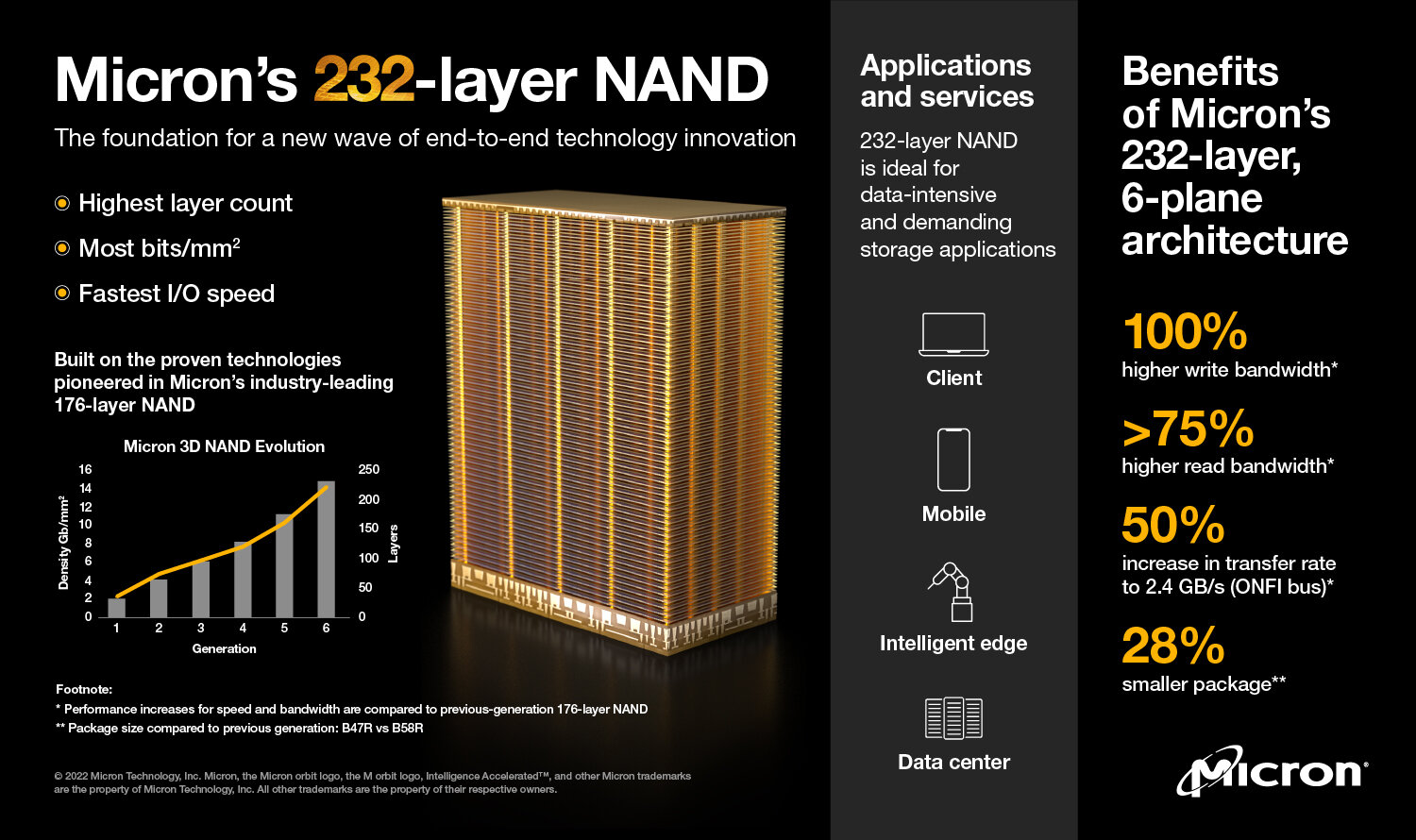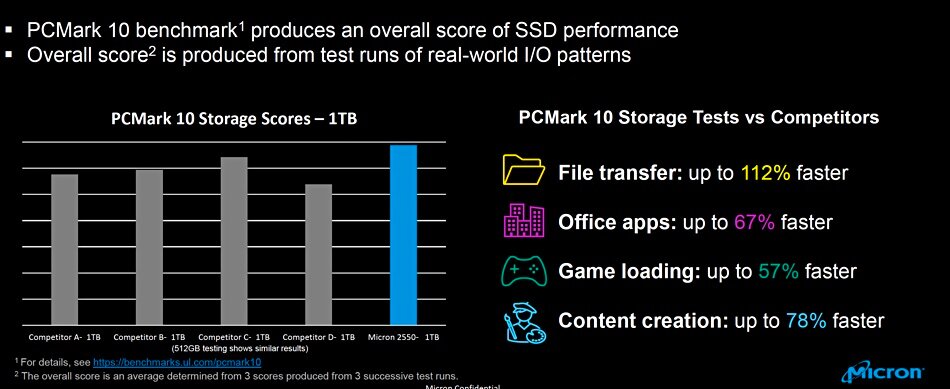Micron had already started series production of its 232-layer 3D-NAND in the summer, but the first SSD series with the new memory is only appearing now. Targeted at consumer OEM systems, the Micron 2550 delivers more performance but surprisingly no more storage capacity than its predecessor.
Faster NAND for more performance
In the footsteps of the Micron 2450, which despite PCIe 4.0 only achieves 3,600 MB/s reading and 3,000 MB/s writing, the Micron 2550 now steps in with significantly higher performance of up to 5,000 MB/s reading and 4,000 MB/s writing . 4K random access IOPS increase slightly up to 550K/600K read/write. The latencies of 50 µs when reading and 12 µs when writing (in the SLC cache) are unchanged.

Instead of the 176-layer TLC NAND the new 232-layer TLC-NAND is used for the first time. This not only offers more cell layers (layers) for higher storage density, but also significantly more performance thanks to the 6-plane design and the interface accelerated to a maximum of 2,400 MT/s. In addition, the storage capacity per die has increased from 512 Gbit to 1,024 Gbit or 1 Tbit.
Fewer chips instead of more capacity
Against this background, it is surprising that the Micron 2550 is again only has a maximum of 1 TB of storage space. However, the number of memory chips required has been halved accordingly. The faster memory throughput ensures that the performance does not decrease, but actually increases.
Micron wants to shine in PCMark
Micron boasts that the 2550 performs better in PCMark 10 than the competition not named in the chart, but the statement remains without independent evidence for the time being to stand in the room. It should be clear to everyone that manufacturers always pick the cherries in such comparisons.
 Micron 2250 should beat competitors in PCMark 10 (Image: Micron (via Blocks and Files))
Micron 2250 should beat competitors in PCMark 10 (Image: Micron (via Blocks and Files))Less power and three formats
There are also improvements in power consumption. In the data sheet for the 2550 (PDF), Micron now speaks of less than 2.5 milliwatts in sleep mode (PS4). When idle (active idle) it should be less than 150 milliwatts; that's a big jump from the <400 mW that the 2450's datasheet (PDF) says. The power consumption when reading should again be less than 5.5 watts.
 Micron 2550 SSD in three M.2 formats (Image: Micron)
Micron 2550 SSD in three M.2 formats (Image: Micron)There is a slight step backwards when it comes to Total Bytes Written (TBW), as the smallest 256 GB model in the 2550 series is only specified with 150 TB write volume (180 TB for the 2450), while the variants with 512 GB and 1 TB again have 300 TB and 600 TB.
There are no changes in the format selection. The Micron 2550 is also available in lengths of 80 mm, 42 mm or 30 mm. Very compact systems can also be equipped with the tiny circuit boards.
The time for PCIe 5.0 is not yet ripe
By the way, Micron does not see the time for PCIe 5.0 for SSDs yet and refers to a study that is still for 2023 and 2024 extremely small quantities expected with the new interface. PCIe 4.0 will still account for the lion's share at least until 2026.
 A study does not see a large spread of PCIe 5.0 SSDs (Image: Micron (via Blocks and Files))
A study does not see a large spread of PCIe 5.0 SSDs (Image: Micron (via Blocks and Files))Fast SSDs with PCIe 5.0 will probably only be the Serving high-end segments in client and server applications. The announced products are already late in the consumer market.
Micron makes the bill without YMTC from China
Micron boasts that the 2550 is the world's first client SSD to ship with 200+ layers of NAND flash.
A first However, a recent report by the chip analysts from Techinsights sees it differently: they examined an SSD from China (Hikvision HikSemi CC700) and discovered the new 232-layer TLC NAND from YMTC. Therefore, from Techinsights perspective, YMTC has preceded Micron in the availability of 200+ layer NAND in an end product.

